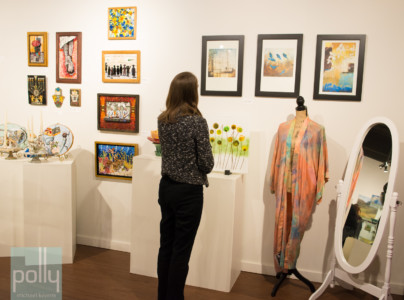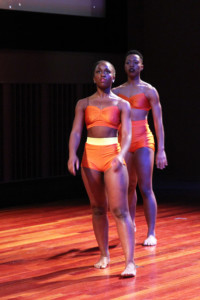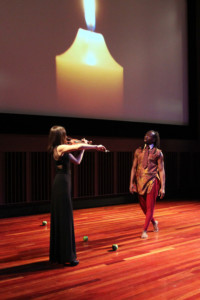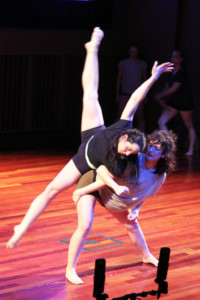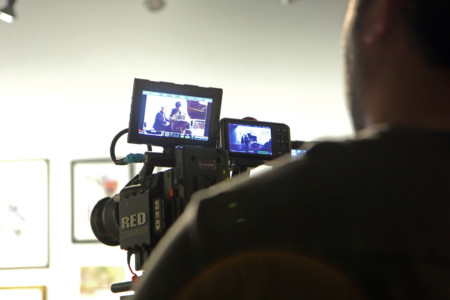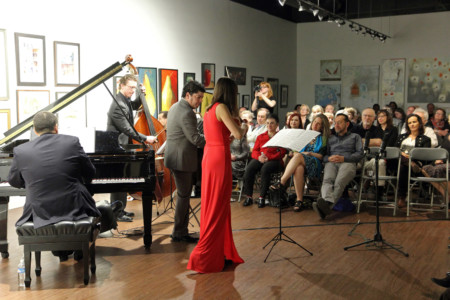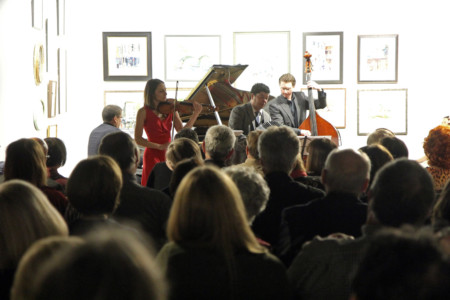Founded by renowned violinist Tatiana Berman, the annual Constella Festival challenges misconceptions of classical music and the performing arts through the creation of original music, interdisciplinary works, and digital content. Since its inception six years ago, Constella has featured an array of internationally renowned artists and presented over sixty world premiere works ranging across genres from jazz to dance, and classical music to visual art.
The seventh annual Constella Festival was held in March of this year with performances that took place at various Cincinnati venues.
Artistic Détente
photography & words | MICHAEL KEARNS
Constella, is “more than a festival, it is a movement.” This movement, while providing educational and showcase opportunities for young artists, [ensures] a vibrant future for self-expression.”
 On Thursday of the festival, Berman, along with director of photography Dan Marque and film director David Donnelly, debuted a program entitled From Russia with Love in the intimate setting of Gallery 708.
On Thursday of the festival, Berman, along with director of photography Dan Marque and film director David Donnelly, debuted a program entitled From Russia with Love in the intimate setting of Gallery 708.
The performance, a beautiful blend of music and digital art, played to an appreciative full house and featured Berman on violin and Kseniia Polstiankina on piano with vocal performances by Fotina Naumenko and Simon Barrad. Envisioned as a form of artistic détente during this recent period of political turmoil, the alternating segments of original film from Donnelly and Marque explored the fluctuating cultural, artistic, and political relationships between Russia and America over the past fifty years. The film segments featured found footage and images of propagandist art, news clips, and visual effects which were interwoven with the musical pieces.
The music was compelling. Of note was the initial offering of Polstiankina—Rachmaninoff Piano Sonata No 1. The performance was both powerful and beautiful and created an introspective start to the entire performance.
 Subsequent performances by Berman and Polstiankina—Shostakovich’s 4 preludes from Op. 34 Arr. Tsyganov—as well as works by Naumenko, soprano, and Barrad, baritone, were also excellent and offered insight into the show’s greater theme identified as “making a strong statement about the power of propaganda, the necessity of free thought, and the unique ability of music to transcend the physical realm.”
Subsequent performances by Berman and Polstiankina—Shostakovich’s 4 preludes from Op. 34 Arr. Tsyganov—as well as works by Naumenko, soprano, and Barrad, baritone, were also excellent and offered insight into the show’s greater theme identified as “making a strong statement about the power of propaganda, the necessity of free thought, and the unique ability of music to transcend the physical realm.”
Holding the performance in the Gallery 708 proved insightful as the space allowed the performances to be explored in an intimate and acoustically appropriate setting. In addition to the performance, patrons were also able to explore the art within Gallery 708—an artist owned and operated gallery promoting the sale and exhibition of local talented artists.
Our Constellations do not Reside in the Skies
photography | DEOGRACIAS LERMA words | TRISH RICHTER
Luminous Dance was held in the Harriet Tubman Theater of the National Underground Railroad Freedom Center and played an incredible compliment to Matthew Willman’s photography exhibit Mandela: The Journey to Ubuntu, which commemorates the life and work of former South African President Nelson Mandela. The intimate nature of this venue offered a more personal setting for a deeper, more organic connection to the audience. The stage was held by the backdrop of a screen with projected video art created by Dan Marque which accompanied each performance.
 The first half of the program featured Cincinnati based MamLuft&Co. Dance. Four dancers enter the stage, two by two, bound together by elastic bands. Their movements occurred in a synchronicity that would seem comfortable if not for their restraints. Bound together with freedom that only extends so far, the tension was palpable as was the release when they unfetter themselves. Inspired by the struggles of caring for a terminally ill spouse, “Intermittent Restraint” is a search for freedom and an expression of the struggle and strength of companionship.
The first half of the program featured Cincinnati based MamLuft&Co. Dance. Four dancers enter the stage, two by two, bound together by elastic bands. Their movements occurred in a synchronicity that would seem comfortable if not for their restraints. Bound together with freedom that only extends so far, the tension was palpable as was the release when they unfetter themselves. Inspired by the struggles of caring for a terminally ill spouse, “Intermittent Restraint” is a search for freedom and an expression of the struggle and strength of companionship.
The remaining performances by MamLuft&Co. focused on barriers and flight. In an exploration of division and conflict, performers danced with a moving wall in “Double|Sided”, a work about both building and bringing down literal and figurative barriers. “In Flight” featured choreographer Susan Honer accompanied by the improvisation of Consetella founder Tatiana Berman on violin. MamLuft&Co. then closed with the world premier of “I am No bird” whose name was derived from the Charlotte Bronte quote, “I am no bird, and no net ensnares me: I am a free human being with an independent will.”
The stage’s energy shifted as two black bodies, both garbed in a striking orange, entered the stage and danced in both synchronicity and conflict in their physical interpretation of the tension that results when we live in two worlds at once. Inspired by Adrienne Kennedy’s writing, Dayton Contemporary Dance Company’s “Funnyhouse” is an exploration of the psychological play of double consciousness as outlined by W.E.B. Du Bois. In The Souls of Black Folks, Du Bois describes this duality: “One ever feels his two-ness, —an American, a Negro; two souls, two thoughts, two unreconciled strivings; two warring ideals in one dark body, whose dogged strength alone keeps it from being torn asunder.”
 This literary thread carried over with “The Angel Gabriel,” which explored a scene from the play Fences, written by African American playwright August Wilson. Dancer Devin Baker inspected the role of the storyteller as played by the character Gabriel. Having suffered a head injury while serving in World War II, Gabriel carries an old trumpet tied around his waist in Fences and believes himself to be the Archangel Gabriel who opens the gates of heaven for St. Peter on Judgment Day. More prophet than man, Gabriel dances and sings around the neighborhood with his basket of fruit and vegetables and warns the story’s protagonist of his tragic fate in the scene interpreted by Baker.
This literary thread carried over with “The Angel Gabriel,” which explored a scene from the play Fences, written by African American playwright August Wilson. Dancer Devin Baker inspected the role of the storyteller as played by the character Gabriel. Having suffered a head injury while serving in World War II, Gabriel carries an old trumpet tied around his waist in Fences and believes himself to be the Archangel Gabriel who opens the gates of heaven for St. Peter on Judgment Day. More prophet than man, Gabriel dances and sings around the neighborhood with his basket of fruit and vegetables and warns the story’s protagonist of his tragic fate in the scene interpreted by Baker.
Accompanied by the improvised violin of Tatiana Berman, Gabriel entered with his basket of apples with which he gradually constructs the outlines of a box around himself as a reference to the fence constructed in Wilson’s play. The screen backdrop held a single flickering candle, as if lit in vigil, and in a blend of dance and attempted flight, Gabriel follows the dialogue of the scene, speaking to St. Peter’s book and the mortality of man. This performance represented the more ethereal and slightly nebulous nature of Gabriel’s character. Baker’s interpretation pays homage not only to the Griot, or bard figure of African mythology, but also to the Flying African who is scattered throughout African American folklore and takes flight to escape the bonds of slavery.
Paired with and inspired by John Coltrane’s “Spiritual,” Dayton’s closing piece featured five dancers who enter the stage grasping books to their chests, eyes lifted towards the sky as they move across the stage in a trance-like sway. One dancer, seemingly awoken, breaks from the group and notices the book in his clutch as if for the first time. Cautiously opening this foreign object, his spirit is overtaken by a new brand of movement that clearly takes root from the book. Gradually the other dancers follow suit in this discovery, and the audience is engaged in a celebration of African American folklore with themes of ritual, loss, joy, and power as paced by Coltrane’s intricate composition.
Coltrane once recounted in a PBS interview that he attended a speech by Malcolm X, and when asked about the relationship between the thoughts espoused by the civil rights leader and Coltrane’s own music, Coltrane said, “Well, I think music, being an expression of the human heart, of the human being, itself, does express just what is happening.” This piece speaks with the weight of history as it explores the role of books, music, and dance within the liberation of slaves and life of the Civil Rights Movement.
Upon leaving the theater, I found yet another thoughtful storyteller to add to the night’s roster. Lebanon native and Cincinnati resident since 1985, Saad Ghosn’s socially and politically themed portfolio of black and white woodcut prints, “SCREAM,” brings a level of discontent and stark discomfort to the viewer. Recently retired medical professional, educator, and founder of the nonprofit SOS (Save Our Souls) Art, Saad has a long-standing history of empowering Cincinnati artists and their use of art as a vehicle for positive social change. His work was the final complement to this eclectic, yet balanced, company of artists. To quote the festival playbook, “Constella is derived from constellation, a group of stars that form a recognizable pattern…we’ve created constellations to make sense of the vastness of the night sky and to fulfill our deep hunger to connect with the bigger world around us.” If this year is any reflection of the future, we at Polly look forward to the festivals to come, as Constella exemplifies the multifaceted nature and interconnectedness of Cincinnati’s arts.
Constella Tangoes to a Close
photography | DEOGRACIAS LERMA words | DOUG GEYER
With framed watercolors and collages providing the backdrop and an eager audience filling Gallery 708, Duo Scofano/Minetti provided a fitting finale to this year’s Constella Festival. Though the evening was slated to close with a Milonga, watching Richard Scofano and his bandoneon, it was clear the dance had already begun.
 Joining Scofano and pianist Alfredo Minetti for most of the evening’s selections were Berman and double-bass player Jeff Greene. As they began to play, tucked carefully yet comfortably into a corner of the gallery, the rapt crowd witnessed why Scofano is revered as one of the world’s preeminent bandoneonists and a courageous composer as well. His innovative style blends the Argentine musical genre Chamamé with Tango and European classical traditions with a dash of folkloric influences.
Joining Scofano and pianist Alfredo Minetti for most of the evening’s selections were Berman and double-bass player Jeff Greene. As they began to play, tucked carefully yet comfortably into a corner of the gallery, the rapt crowd witnessed why Scofano is revered as one of the world’s preeminent bandoneonists and a courageous composer as well. His innovative style blends the Argentine musical genre Chamamé with Tango and European classical traditions with a dash of folkloric influences.
A member of the concertina family, the bandoneon is held between the hands like a small accordion. The musician expands or compresses the bellows while pressing buttons to channel air through various reeds. In the hands of Scofano, however, his seemed less like an instrument than his external lungs or beating heart. While his fellow musicians followed closely with their sheet music, Scofano played without the assistance of written notes. The rich and surprising sounds and their accompanying emotions were seemingly summoned up from somewhere much deeper and much older than even his 1938 bandoneon. It was as if he was channeling the three generations of bandoneonists he has descended from, celebrating their spirits and contributions with both old-world cultures and otherworldly compositions.
With eyes closed, he swayed and bobbed, weaving the notes through the air with his expressions, drawing together both the performers and those seated just feet away. After Minetti introduced each piece, giving the listeners the context for the coming composition, the foursome, themselves, danced with and around each other’s notes as Scofano guided, urging them on with nods and smiles.
A portion of the first act featured original pieces dedicated to the four seasons. Invierno (Winter) was inspired by Scofano’s time in Chicago—a survival story of a transplanted South American enduring a Midwest winter. Starting slowly, deliberately, you could see the flakes falling, thick and lumbering. All at once, gusts of wind reanimated the snow, swirling, and whirling with each breath from the reeds. As the song concluded, it felt like more than Scofano surviving—perhaps even embracing the shock of the different and making it his own.
 In the second act, Scofano stepped back and out of the spotlight to let Berman, Minetti, and Greene enjoy the company of each other’s music. Rejoining them, it seemed Scofano’s intent to close powerfully while setting up the dance portion of the evening sponsored by Tango Del Barrio—Cincinnati’s premier Argentine Tango venue. Their notes continued to dance, cheek to cheek, expanding the world while contracting the room.
In the second act, Scofano stepped back and out of the spotlight to let Berman, Minetti, and Greene enjoy the company of each other’s music. Rejoining them, it seemed Scofano’s intent to close powerfully while setting up the dance portion of the evening sponsored by Tango Del Barrio—Cincinnati’s premier Argentine Tango venue. Their notes continued to dance, cheek to cheek, expanding the world while contracting the room.
With the chairs cleared and the dancers poised, the Milonga began. Dancers, both skilled and learning, nuanced and new, kept the intentional intimacy of the evening alive. Faces pressed softly together, writing and reading personal short stories with music providing the soundtrack, feet tracing figures on the floor, each couple sharing their own private world in this special, public space.
Just like Constella, the evening’s music and dancing were moving and unexpected. Art was created in the moment, making the foreign more familiar and the distant more accessible.












